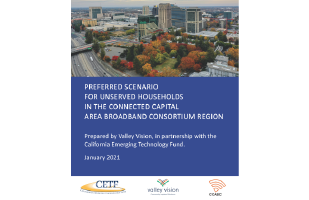Introduction
In the digital age, fast and reliable internet is indispensable to equity and economic development. Without it, community members are barred from full access to basic services, job opportunities, and other tools and paths for improving quality of life.
Valley Vision, in partnership with the California Emerging Technology Fund (CETF), is at the center of strategic efforts to improve broadband access in California’s Capital Region, paving the way for future-ready infrastructure and regional prosperity. In 2020, this was embodied in its work contributing to state broadband policy, its continued role as manager of the Connected Capital Area Broadband Consortium (“the Consortium”), and its management of the Sacramento Coalition for Digital Inclusion, among others. Broadband infrastructure and adoption is also identified as a high priority in the region’s Prosperity Strategy1, which Valley Vision co-authored and released together with its civic leadership partners.
What Is A Preferred Scenario?
In 2017, CETF sponsored AB 1665, the “Internet For All Now Act,” which established the statutory goal of achieving 98% broadband availability in households in each consortium region of California. AB 1665 assigned to the California Public Utilities Commission (CPUC) the responsibility of achieving this goal, and directed them to optimize opportunities to leverage federal funding and other resources. During the rulemaking process for the implementation of AB 1665, CETF recommended that the CPUC work with the Regional Consortia to engage Internet Service Providers and local governments in developing a“Preferred Scenario” to reach the 98% goal.

